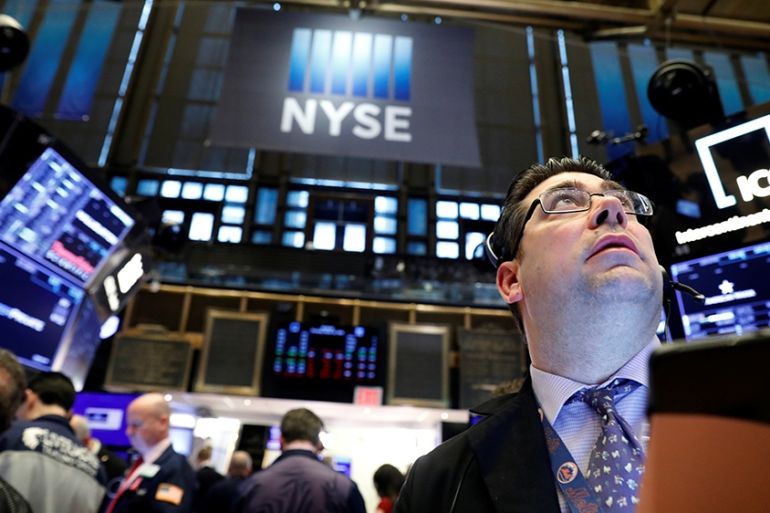Dow falls 2,300 points – worst one-day loss since 1987 crash
Stocks were hammered, oil prices plunged- even bitcoin and gold weren’t spared from coronavirus fear carnage.

As trading days go, Thursday’s session on Wall Street was a terrible, horrible, no good, very bad one.
Stocks were annihilated, oil plunged, credit markets tightened – even gold and bitcoin weren’t spared from the carnage as anxiety over how deeply coronavirus could damage the economy continued to decimate investor confidence.
Keep reading
list of 3 itemsOil falls 8% as price war heats up, Trump bans travel from Europe
Coronavirus: US suspends all travel from Europe, except UK
An announcement of a major funding injection by the United States Federal Reserve – aimed at flushing out financial plumbing gummed up by growing investor panic – only managed to stem the bloodbath briefly.
The Dow Jones Industrial Average closed down 2,356.60 points or just shy of 10 percent – its biggest one-day plunge since the 1987 market crash, when it lost 22 percent in a single session.
The broader S&P 500 – a proxy for US retirement and college savings plans – closed down 9.5 percent, officially landing it in bear market territory. Shortly after the opening bell, the index crossed the 7 percent loss threshold, triggering so-called circuit breakers that halted trading for 15 minutes.
The tech-heavy Nasdaq Composite Index also sank into bear market turf, closing down 9.4 percent.
Wall Street opened under a cloud of despair as fears over the economic fallout of coronavirus accelerated after US President Donald Trump on Tuesday announced a travel ban on Europe.
During a televised address to the nation, Trump labelled the coronavirus “foreign” and listed measures that had been previously floated – such as tax breaks and small business aid – to help offset the outbreak’s economic impacts. But he failed to include enough details to assuage recession fears.
“The buildup to the address, especially the comments made during the President’s televised discussion with bank CEO’s earlier in the day, left the impression that a more complete outline of the Administration’s stimulus plan would be presented during last night’s address,” Steven Ricchiuto, chief US economist at Mizuho Securities USA, wrote in a note to clients. “Markets want a credible, coordinated stimulus plan and policymakers have left investors wanting. The net result is that markets keep pricing in the worst-case scenario.”
That scenario kept gaining the upper hand on Thursday.
As businesses scrambled to get their hands on cash to weather the coronavirus storm, short-term funding markets that banks rely on to fund their day-to-day operations continued to tighten.
In an effort to calm nerves and ease the stress, the Federal Reserve announced around 1pm in New York that it is injecting $1.5 trillion in funding into short-term credit markets over Thursday and Friday.
The liquidity firepower served as tourniquet – but only briefly- and ultimately could not stem the hemorrhaging in share prices.
Airline stocks took another pummeling in the wake of the travel ban on Europe, which caught carriers by surprise and drew criticism from US Travel Association President and CEO Roger Dow.
“Temporarily shutting off travel from Europe is going to exacerbate the already-heavy impact of coronavirus on the travel industry and the 15.7 million Americans whose jobs depend on travel,” Dow said in a statement.
Energy shares also continued to get hammered as oil prices kept faltering following Monday’s crash.
Oil markets are getting hit with a demand shock from coronavirus as appetites for crude ebb with business activity, and a supply shock from Saudi Arabia, which lowered the price it charges for oil and is flooding an already oversaturated market with crude in retaliation for Russia refusing to support deep output cuts.
Global benchmark Brent crude was down more than eight percent at around $33 barrel on Thursday, while US benchmark West Texas Intermediate crude was off more than six percent at around $31 a barrel.
The scramble for cash to cover deteriorating trading positions spilled over into gold, where the spot price fell below $1,600 per ounce.
The virtual cryptocurrency bitcoin also lost its lustre, with prices crashing below $6,000.
Trump and the Federal Reserve were not the only ones unveiling measures on Thursday that failed to assuage investor fears.
The European Central Bank (ECB) announced a stimulus package to shore up the eurozone against coronavirus economic hits, including boosting its bond-buying programme and making cheap loans available to banks to keep credit flowing smoothly.
But the ECB opted to leave interest rates unchanged, disappointing investors who had expected policymakers to lower rates following emergency cuts by both the US Federal Reserve and the Bank of England.
“While these measures are pretty substantial, we do not think the ECB will be able to change investor sentiment any more than the Fed could last week,” said Andrew Kenningham, chief Europe economist at Capital Economics.